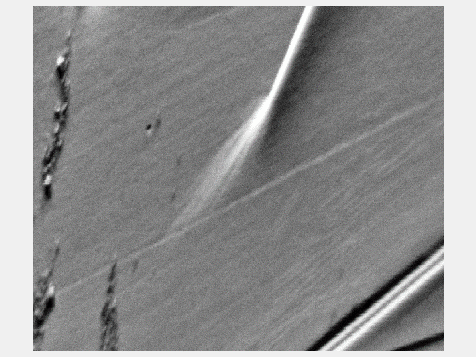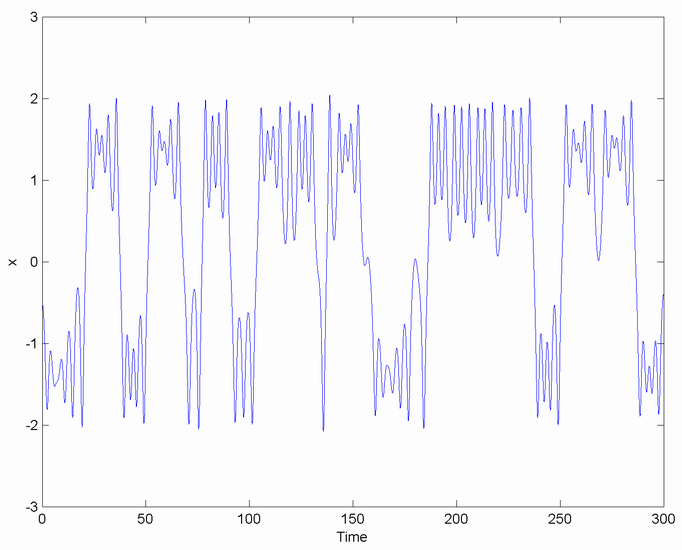|
Dislocation Avalanches
Dislocation avalanches are rapid discrete events during plastic deformation, in which defects are reorganized collectively. This intermittent flow behavior has been observed in microcrystals, whereas macroscopic plasticity appears as a smooth process. Intermittent plastic flow has been observed in several different systems. In AlMg Alloys, interaction between solute and dislocations can cause sudden jump during dynamic strain aging. In metallic glass, it can be observed via shear banding with stress localization; and single crystal plasticity, it shows up as slip burst. However, analysis of the events with orders-magnitude difference in sizes with different crystallographic structure reveals power-law scaling between the number of events and their magnitude, or scale-free flow. This microscopic instability of plasticity can have profound consequences on mechanical behavior of microcrystals. The increased relative size of the fluctuations makes it difficult to control the plastic form ... [...More Info...] [...Related Items...] OR: [Wikipedia] [Google] [Baidu] |
Barkhausen Effect
The Barkhausen effect is a name given to the noise in the magnetic output of a ferromagnet when the magnetizing force applied to it is changed. Discovered by German physicist Heinrich Barkhausen in 1919, it is caused by rapid changes of size of magnetic domains (similarly magnetically oriented atoms in ferromagnetic materials). Barkhausen's work in acoustics and magnetism led to the discovery, which became the main piece of experimental evidence supporting the domain theory of ferromagnetism proposed in 1906 by Pierre-Ernest Weiss. The Barkhausen effect is a series of sudden changes in the size and orientation of ferromagnetic domains, or microscopic clusters of aligned atomic magnets (spin (physics), spins), that occurs during a continuous process of magnetization or demagnetization. The Barkhausen effect offered direct evidence for the existence of ferromagnetic domains, which previously had been postulated theoretically. Heinrich Barkhausen discovered that a slow, smooth inc ... [...More Info...] [...Related Items...] OR: [Wikipedia] [Google] [Baidu] |
Slip Bands
Formation of slip bands indicates a concentrated unidirectional slip on certain planes causing a stress concentration. Typically, slip bands induce surface steps (e.g., roughness due persistent slip bands during fatigue) and a stress concentration which can be a crack nucleation site. Slip bands extend until impinged by a boundary, and the generated stress from dislocation pile-up against that boundary will either stop or transmit the operating slip. Formation of slip bands under cyclic conditions is addressed as persistent slip bands (PSBs) where formation under monotonic condition is addressed as dislocation planar arrays (or simply slip-bands, see ''Slip bands in the absence of cyclic loading'' section). Slip-bands can be simply viewed as boundary sliding due to dislocation glide that lacks (the complexity of ) PSBs high plastic deformation localisation manifested by tongue- and ribbon-like extrusion. And, where PSBs normally studied with (effective) Burger’s vector aligned ... [...More Info...] [...Related Items...] OR: [Wikipedia] [Google] [Baidu] |
Lüders Band
Lüders bands, is type of slip bands in metals or stretcher-strain marks which are formed due to localized bands of plastic deformation in metals experiencing tensile stresses, common to low-carbon steels and certain Al-Mg alloys. First reported by Guillaume Piobert, and later by W. Lüders, the mechanism that stimulates their appearance is known as dynamic strain aging, or the inhibition of dislocation motion by interstitial atoms (in steels, typically carbon and nitrogen), around which "atmospheres" or "zones" naturally congregate. As internal stresses tend to be highest at the shoulders of tensile test specimens, band formation is favored in those areas. However, the formation of Lüders bands depends primarily on the microscopic (i.e. average grain size and crystal structure, if applicable) and macroscopic geometries of the material. For example, a tensile-tested steel bar with a square cross-section tends to develop comparatively more bands than would a bar of identical com ... [...More Info...] [...Related Items...] OR: [Wikipedia] [Google] [Baidu] |
Portevin–Le Chatelier Effect
The Portevin–Le Chatelier (PLC) effect describes a serrated stress–strain curve or jerky flow, which some materials exhibit as they undergo plastic deformation, specifically inhomogeneous deformation. This effect has been long associated with dynamic strain aging or the competition between diffusing solutes pinning dislocations and dislocations breaking free of this stoppage. The onset of the PLC effect occurs when the strain rate sensitivity becomes negative and inhomogeneous deformation starts. This effect also can appear on the specimen's surface and in bands of plastic deformation. This process starts at a so-called critical strain, which is the minimum strain needed for the onset of the serrations in the stress–strain curve. The critical strain is both temperature and strain rate dependent. The existence of a critical strain is attributed to better solute diffusivity due to the deformation created vacancies and increased mobile dislocation density. Both of these contr ... [...More Info...] [...Related Items...] OR: [Wikipedia] [Google] [Baidu] |
Acoustic Emission
Acoustic emission (AE) is the phenomenon of radiation of acoustic (elastic) waves in solids that occurs when a material undergoes irreversible changes in its internal structure, for example as a result of crack formation or plastic deformation due to aging, temperature gradients or external mechanical forces. In particular, AE is occurring during the processes of ''mechanical loading'' of materials and structures accompanied by structural changes that generate local sources of elastic waves. This results in small surface displacements of a material produced by elastic or stress waves generated when the accumulated elastic energy in a material or on its surface is released rapidly. The waves generated by sources of AE are of practical interest in structural health monitoring (SHM), quality control, system feedback, process monitoring and other fields. In SHM applications, AE is typically used to detect, locate and characterise damage. Phenomena Acoustic emission is the transient elas ... [...More Info...] [...Related Items...] OR: [Wikipedia] [Google] [Baidu] |
Transmission Electron Microscopy
Transmission electron microscopy (TEM) is a microscopy technique in which a beam of electrons is transmitted through a specimen to form an image. The specimen is most often an ultrathin section less than 100 nm thick or a suspension on a grid. An image is formed from the interaction of the electrons with the sample as the beam is transmitted through the specimen. The image is then magnified and focused onto an imaging device, such as a fluorescent screen, a layer of photographic film, or a sensor such as a scintillator attached to a charge-coupled device. Transmission electron microscopes are capable of imaging at a significantly higher resolution than light microscopes, owing to the smaller de Broglie wavelength of electrons. This enables the instrument to capture fine detail—even as small as a single column of atoms, which is thousands of times smaller than a resolvable object seen in a light microscope. Transmission electron microscopy is a major analytical method i ... [...More Info...] [...Related Items...] OR: [Wikipedia] [Google] [Baidu] |
Dislocation
In materials science, a dislocation or Taylor's dislocation is a linear crystallographic defect or irregularity within a crystal structure that contains an abrupt change in the arrangement of atoms. The movement of dislocations allow atoms to slide over each other at low stress levels and is known as ''glide'' or slip. The crystalline order is restored on either side of a ''glide dislocation'' but the atoms on one side have moved by one position. The crystalline order is not fully restored with a ''partial dislocation''. A dislocation defines the boundary between ''slipped'' and ''unslipped'' regions of material and as a result, must either form a complete loop, intersect other dislocations or defects, or extend to the edges of the crystal. A dislocation can be characterised by the distance and direction of movement it causes to atoms which is defined by the Burgers vector. Plastic deformation of a material occurs by the creation and movement of many dislocations. The number and a ... [...More Info...] [...Related Items...] OR: [Wikipedia] [Google] [Baidu] |
Slip (materials Science)
In materials science, slip is the large displacement of one part of a crystal relative to another part along crystallographic planes and directions. Slip occurs by the passage of dislocations on close/packed planes, which are planes containing the greatest number of atoms per area and in close-packed directions (most atoms per length). Close-packed planes are known as ''slip'' or ''glide planes''. A slip system describes the set of symmetrically identical slip planes and associated family of slip directions for which dislocation motion can easily occur and lead to plastic deformation. The magnitude and direction of slip are represented by the Burgers vector, . An external force makes parts of the crystal lattice glide along each other, changing the material's geometry. A critical resolved shear stress is required to initiate a slip., Hull D., Bacon, D.J (2001); "Introduction to Dislocations", 4th ed., Slip systems Face centered cubic crystals Slip in face centered cubic (f ... [...More Info...] [...Related Items...] OR: [Wikipedia] [Google] [Baidu] |
Intermittency
In dynamical systems, intermittency is the irregular alternation of phases of apparently periodic and chaotic dynamics ( Pomeau–Manneville dynamics), or different forms of chaotic dynamics (crisis-induced intermittency). Pomeau and Manneville described three routes to intermittency where a nearly periodic system shows irregularly spaced bursts of chaos. These (type I, II and III) correspond to the approach to a saddle-node bifurcation, a subcritical Hopf bifurcation, or an inverse period-doubling bifurcation. In the apparently periodic phases the behaviour is only nearly periodic, slowly drifting away from an unstable periodic orbit. Eventually the system gets far enough away from the periodic orbit to be affected by chaotic dynamics in the rest of the state space, until it gets close to the orbit again and returns to the nearly periodic behaviour. Since the time spent near the periodic orbit depends sensitively on how closely the system entered its vicinity (in turn dete ... [...More Info...] [...Related Items...] OR: [Wikipedia] [Google] [Baidu] |
Solid Mechanics
Solid mechanics, also known as mechanics of solids, is the branch of continuum mechanics that studies the behavior of solid materials, especially their motion and deformation under the action of forces, temperature changes, phase changes, and other external or internal agents. Solid mechanics is fundamental for civil, aerospace, nuclear, biomedical and mechanical engineering, for geology, and for many branches of physics such as materials science. It has specific applications in many other areas, such as understanding the anatomy of living beings, and the design of dental prostheses and surgical implants. One of the most common practical applications of solid mechanics is the Euler–Bernoulli beam equation. Solid mechanics extensively uses tensors to describe stresses, strains, and the relationship between them. Solid mechanics is a vast subject because of the wide range of solid materials available, such as steel, wood, concrete, biological materials, textiles, geological ... [...More Info...] [...Related Items...] OR: [Wikipedia] [Google] [Baidu] |







.jpg)